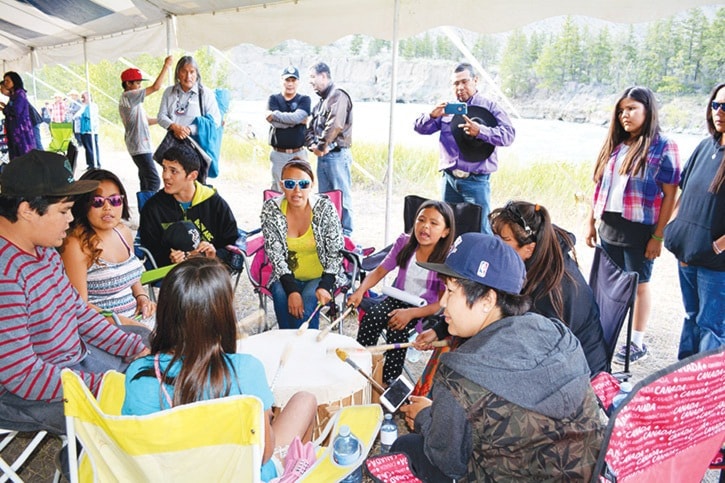Against the backdrop of Farwell Canyon and the Chilcotin River, First Nations gathered Wednesday to celebrate the one-year anniversary of the Supreme Court of Canada decision to declare full Aboriginal title to approximately 1,900 kilometres of land to the Tsilhqot’in.
Organizers of the event chose Farwell Canyon because when the decision came down on the morning of June 26, 2014 many people who were participating in the annual Xeni Gwet’in Wagon Ride to the Williams Lake Stampede were camped at that spot.
Xeni Gwet’in Chief Roger William said the youth who were on the wagon trip last year and again this year will remember witnessing the reaction of the elders and adults when they realized they’d won.
“There are a lot of our youth here and they will remember this,” William said. “We First Nations know what Aboriginal Rights and Title are but it’s the government that need to recognize it.”
Chief Joe Alphonse described the day as one of renewed hope.
“The decision has given us an opportunity to push the reset button and fix our relationships with the provincial and federal governments,” Alphonse said.
He described the last year as a whirlwind because it put the Tsilhqot’in on the map.
“First Nations across Canada opened their doors to us,” he said. “Indigenous people in Belize were even celebrating for us.”
Yunesit’in Chief Russell Myers Ross recalled the excitement and shock from all parties when the Supreme Court decision was announced.
“Even though a year has passed, there are still outstanding issues,” Myers Ross said. “Xeni Gwet’in got title but there is still the rest of the Tsilhqot’in territory that needs to be reconciled. We as people need to express our history and explain where we want to go.”
B.C.’s Aboriginal Relations Minister John Rustad said he was excited to be at a time in history when First Nations and the government are exploring what peace can look like.
“I know there’s been conflict for a long period of time,” Rustad said. “It culminated in this court case. The province fought against the Tsilhqot’in, but you won it. The province recognizes the win and celebrates it.”
Rustad said the government has heard concerns from First Nations about education, children and families, wildlife management, fish habitat and the justice system.
“These are the types of things we are negotiating,” Rustad said. “We as a non-Aboriginal people came in and took away that management.”
He said he is hopeful negotiations can be done in three to five years and not take generations.
“It is fragile and won’t be easy because there is 150-years plus of history.”
?Esdilagh Chief Bernie Mack said the challenge for the Tsilhqot’in is to let the decision become the game changer everyone else says it is.
“I see a day down the future where we as Tsilhqo’tin will be owning and running a big company,” Mack said.
As the celebration came to a close William said many Tsilhqot’in people are strong and thriving, know the language, go out onto the land, have university degrees and jobs, but there are those who are struggling.
“There’s alcohol, drugs and gangs, but it’s within us to get the resources to be able to deal with what is affecting us,” he added.
